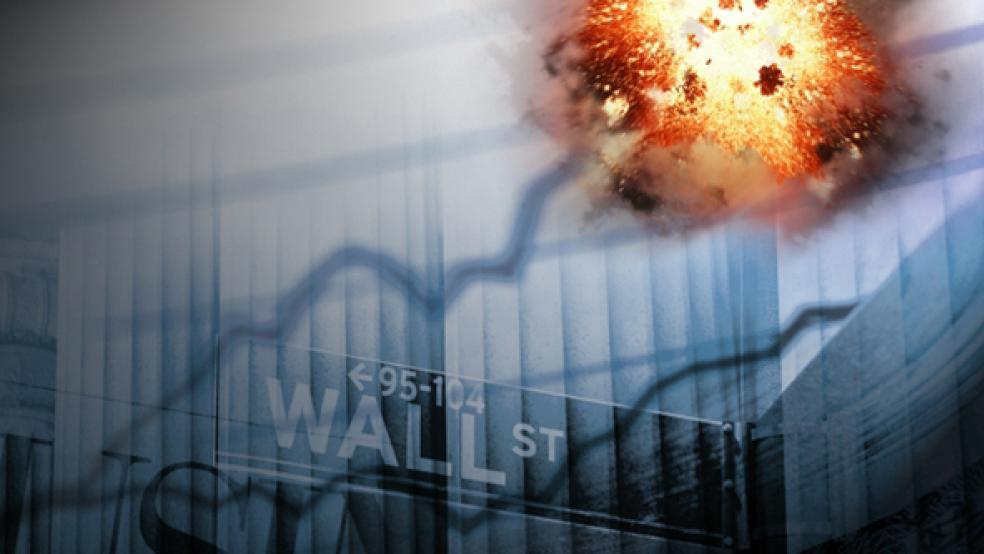After months of easy, low volatility gains, investors have been shocked back to reality by a bout of selling pressure this week.
On Thursday, the Dow Jones Industrial Average suffered its most dramatic decline since early February and the emerging market scare that rattled stocks at the start of the year. The Dow plunged below its lower Bollinger Band and its 50-day moving average, both of which are significant technical support levels. Moreover, the CBOE Volatility Index, known colloquially as Wall Street's "fear gauge," jumped 27 percent to reach a level not seen since April.
This is all a pretty major change from recent trends, which featured calm and consistent incremental gains to new record highs. But as the negatives accumulated — from geopolitical hotspots and the standoff with Russia to the Fed's movement toward monetary policy tightening — investors were looking more and more complacent instead of merely confident.
In fact, measured market volatility had dropped to the bottom 1 percent of all readings since 1928. Looking back at market history, there have been 15 other examples of this happening with stocks near new highs, according to the team at SentimenTrader. In only two of these 15 examples did the market continue higher unimpeded. And sure enough, we're seeing the sellers reassert themselves here.
Related: Here’s What Is Pushing the Stock Market Down
The downside impetus started on Wednesday in the wake of the release of the Federal Reserve Open Market Committee policy statement, which analysts at Goldman Sachs noted had a "slightly hawkish tilt" as it acknowledged recent improvements to economic growth and the job market as well as an increase in inflation to near its 2 percent annual target. The one dovish throwaway was a shift in focus away from the unemployment rate to alternative measures of labor market slack, such as wage growth, long-term unemployment and the like.
But the real kicker came from Philadelphia Federal Reserve President Charles Plosser, who dissented and voted against the statement because of his objection to the commitment to hold interest rates near zero "for a considerable time" after the QE3 bond-buying stimulus ends (likely in October, as things stand now) because "such language is time dependent and does not reflect the considerable economic progress that has been made toward the Committee's goals."
The policy hawks are quickly making their reservations known, with Plosser's vote coming on the heels of Dallas Fed President Richard Fisher's Wall Street Journal Op-Ed on Tuesday titled "The danger of too loose, too long."
Combined with the very strong 4 percent annualized GDP growth posted in Q2 (rebounding from the upwardly revised 2.1 percent contraction in Q1) and firming inflationary pressure (the GDP price index rose to 2 percent) and it looks like the hawks are about go on the attack.
Related: Market 'Black Swan' Fear at Record High
It's worth noting that it's been eight years since the Fed last increased the cost of money. So it's a big deal that a change in policy is approaching, with the first rate hikes due sometime in the middle of 2015, and possibly sooner should inflation, housing and the job market rise faster than the Fed expects.
This was the conclusion reached by analysts at Stone McCarthy Research, reminding clients that the emergence of a dissent in the Fed policy statement — or a string of dissents — "often signaled when a change in monetary policy was approaching." On the other hand, Plosser has been no stranger to a dissenting vote, casting two in 2011 and another two in 2008, during his last annual two rotations as a Fed voter.
So investors are understandably growing nervous — sentiment we've already seen reflected in recent pullbacks in more sensitive (and overvalued) areas of the market, including small-cap stocks and high-yield corporate bonds.
The truth is, we're deep into uncharted territory and no one, not even the Fed, knows what will happen when it starts draining liquidity.
Related: Don’t Ignore Janet Yellen’s Stock Market Warnings
Banks are lamenting the potential loss of deposit reserves of as much as $1 trillion when the Fed starts tightening. The Bank for International Settlements has recently warned of a number of problems, including evidence of a global search for yield, risk of financial imbalances building up in some regions, and high interest rate sensitivity of the corporate bond market. And the Institute of International Finance is concerned that any surprises from the Fed "would set the stage for a potentially large correction in asset valuations when short-term rates rise" because of lofty valuations relative to fundamentals and crowded "one-way" positioning in various asset classes, including developed market stocks. They highlight higher corporate leverage as a specific risk for the high-yield bond market.
The hawks’ emphasis that the Fed milestone is fast approaching provided the catalyst necessary to rattle the seemingly invincible stock market.
As long as the economy keep clawing forward, the likes of Plosser and Fisher will push for rate hikes to prevent higher inflation and runaway market bubbles. We could see some real fireworks. Historically, the market has had to deal with some bumps in the road about six months before the Fed actually raises rates. This time will feel much worse than that, however, given that investors haven't had to deal with a significant market correction since 2011.
The next big hurdle could come from Friday’s nonfarm payroll report for July. The team at Capital Economics believes we could see the unemployment rate fall to just six percent, two-tenths above the Congressional Budget Office's estimate of full employment. If that happens, in what would in normal times be considered great news, stocks could get hit hard again as investors grow convinced that the first Fed rate hike will come in early 2015.
Anthony Mirhaydari is founder of the Edge and Edge Pro investment advisory newsletters, as well as Mirhaydari Capital Management, a registered investment advisory firm.
Top Reads from The Fiscal Times:







